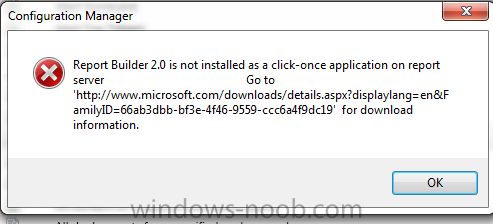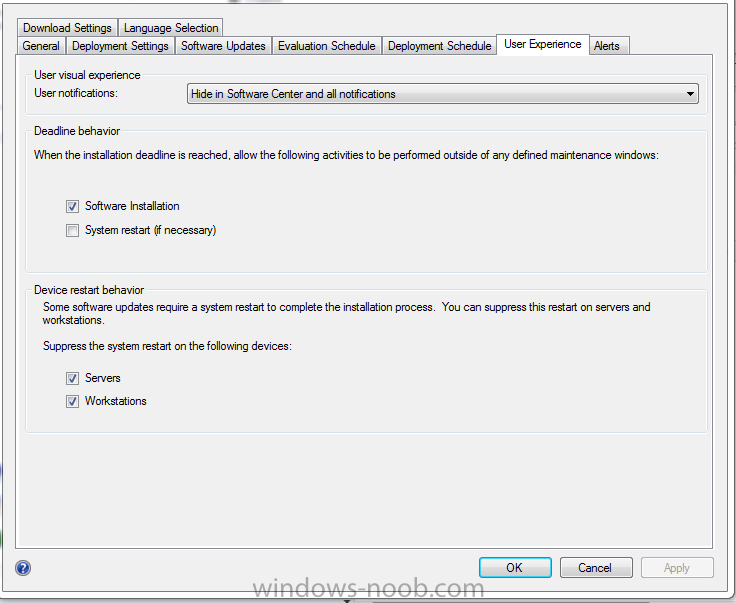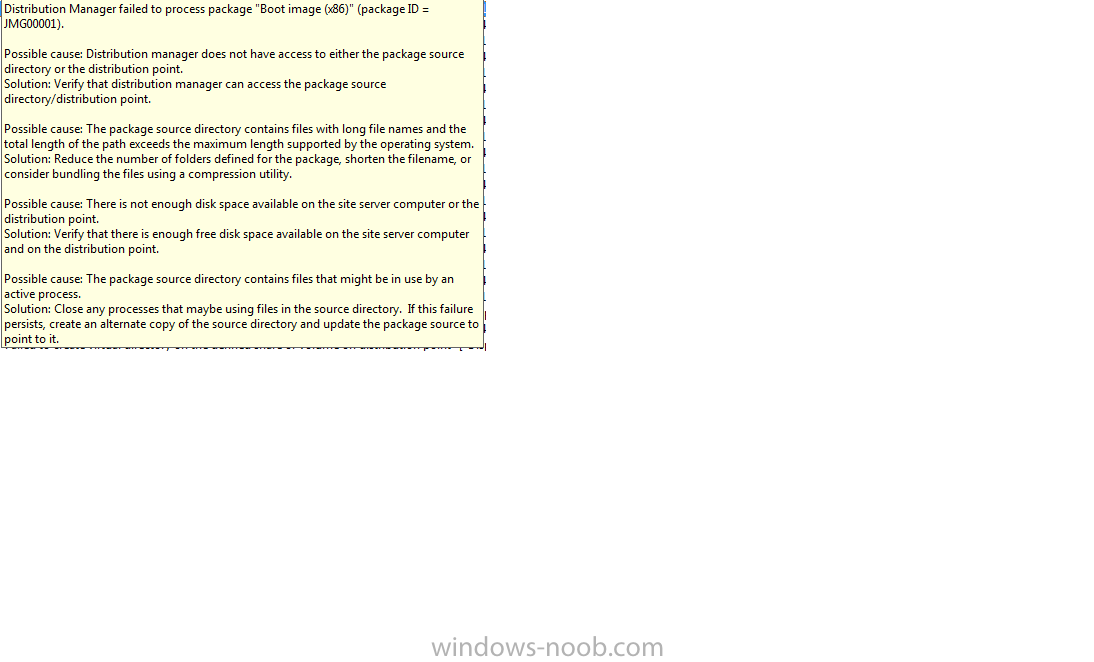
Coenie
-
Posts
31 -
Joined
-
Last visited
-
Days Won
2
Posts posted by Coenie
-
-
Hi,
I've been sitting with a problem, whereby no updates go through to computers, although it has synchronized properly, and no errors are shown.
I've followed the guides on this site step-by-step, and I get no noticeable errors.
If I try to send and update using wsus, it goes through fine.
This is the case when it comes to auto deployments for anti-virus definition updates, and windows updates, selecting the updates to deploy, creating a software update group, deployment package and deploying it to a collection.
What logs can I check, as no errors are reported whatsoever, and the updates simply do not come through, even though they are distributed to the distribution point, etc.
Any assistance would be appreciated.
Thanks.
Coenie
-
Hi,
Thanks, UAC is disabled on a domain level, but I have also ran as administrator, and the changes stay in registry, and does not reset.
Any other advice would be appreciated.
-
Thank you,
This looks really promising.
-
-
Hi,
I've come across a Report Builder issue, which is quite baffling.
I have installed Report builder 3 , and two in the meantime, and tried the fixes as below, switching between two and three respectively within registry, but no luck
I've also tried to launch configmgr as local administrator, and two domain admin accounts on two seperate domains, and still no luck, please advise.
http://social.techne...4e-329698a917f2
Thanks.
Coenie
-
Hi,
I'm wondering if it is possible to pull in only computer objects that are part of a specific Active directory Security group to a collection, and how such a query will look.
Has anyone had to do this in the past, and is it possible?
Ultimately we would like to separate computers by departments, and our AD access is such that we cannot create new ou's.
Thanks.
Coenie
-
Hi,
Did you create a "client settings" template for the systems in question, and under "Remote tools", have you stipulated "Permitted viewers of remote Control and Remote Asisstance"?
Thanks.
Coenie
-
-
I honestly don't remember exactly where the setting is (during package creation, or deployment), you can try "Run as Administrator" or something similar, and see what this does for you.
Also, can the users physically access the software share?
-
As far as I've been able to see, is that it requires MDT to enable the functionality of installing Windows 8, and Server 2012.
MDT also integrates with sp1 to a certain degree.
Think of it as a supplement to WDS.
-
We had a similar issue, and had to go manually approve Server 2003 systems within the SCCM console.
-
Hi,
I decided to share our basic space requirements for our SCCM instance, managing approximately 500 computers/servers , as I have not really seen documentation related to this before.
Before you start implementing SCCM , it's always good to first pause, and concider the layout.
Currently we use three sccm servers, for our purposes, lets call them SCCMA , SCCMB, and SCCMC
On SCCMA you would keep a distribution point, and WSUS, and allot of roles, at your discretion .
It is important that you have a seperate hard-drive for WSUS , and a Seperate one for your distribution point(Added before installing this role~very important, and set to take preference over your c: drive).
Wsus, and your distribution points can easily take up up to 100gb each if fully utilized, and depending on the implementation.
It is also important that you leave room for growth on your c: drive for SCCM components ( Please also note, that it is not best practice to have sccm on your C: drive).
SCCMB:
This server would ideally be used for your SQL database, and maybe some SCCM roles, not that resource hungry.
Here it is vital to store your database on a separate hard-drive as to avoid long disc ques, and increase the overall responsiveness of the sccm system.
SCCMC:
This server is usually perfect for pxe boot functionality, and works perfectly to prioritise pxe traffic, as the server would be dedicated to this role.
As with any distribution point role, have a second hard-drive, installed before installing the role, and with enough space to handle operating sstem, boot image, driver , etc storage requirements (This should not go over 50gb neccesarily, depending on implementation) . Note to always assign more space, rather than less.
Physical processing power, and memory requirements:
Remember, SCCM servers are quite resource intensive, and it is vital that they have good network connectivity to your systems (1gbps is a good thought) .
Processing power requirements is usually not that bad, and two virtual processors should usually do the trick, depending on the amount of roles installed on the server.
Ram requirements:
This is where bottlenecks tend to occur on these systems, and when it's busy polling systems, or performing maintenance it can really utilize your memory.
It is vital them to have atleast 12gb ram on each of your sccm servers, also dependant on the roles, and the amount of users the servers would be responsible for.
If you can think, or see anything you do not agree with, please don't be hesitant to post.
-
Hi,
I decided to share some dependencies of certain sccm roles, and their related services with all, which might have caused headaches for some.
Please add basic troubleshooting steps for common issues if you find some.
If wsus does not start up, please ensure the following:
Is your sql server service running?(This is only if your WSUS database is hosted on the sccm sql database)
If you have difficulties accessing the sccm management console, restart the MSSQL service in services.msc
If pxe boot does not work properly, restart the wds role.
If wds does not start up, restart the "Server" service, and retry.
Note to always set your WDS service to "Delayed start", as to give time for your depaendant services to start up first.
As a rule of thumb, when communication issues are experienced, it should be the first step to restart the mssql service.
If boot images, etc are inaccessible, ensure that WAIK is installed.
When you experience update issues, after a windows update has come through, remember that sometimes hotfixes are available for the WSUS server instance to restore communication.
-
 1
1
-
-
OK,
I'm going to attempt to setup a third system within our sccm infrastructure, and add a distribution point onto that one, with pxe support, waik and WDS, will update on if this resolves the issue, as I'm not planning a reinstall of the entire system.
------------------------------------------------------------
I finally got this sorted by setting up a new site server, and configuring it for pxe, and distributing all os related packages to it.
I recreated a task sequence, and so forth, now it works perfectly.

So, to sum up, it was my existing distribution point that caused the issues, as I added a hard-drive to it after the innitial installation, and moved the dp to it.
Thanks.
-
 1
1
-
-
To clarify, the 10 gigs are free space on C, although admittedly low, I can't see it being the issue, as the boot image is a total of 1.2 gigs +-.
-------
Copied both the source and the destination file to my E$ drive (150gb free space), and appended it within sccm on the boot image settings, and still nothing, so it's definitely not a space issue, or a access issue.
--------------------------
I have, after installing added a new hard-drive to the server, and uninstalled, and reinstalled the dp on the server for the new drive to take presedence over the old one.
This, as I have read might be related to the issue.
A fix, as per allot of people, is to uninstall the dp, remove all the dp content locations, and then reinstalling the dp.
My question would be if this would actually work, and second, what directories do I actually need to remove?
-
Hi thanks,
I'm transferring the image from my C drive(10gb free) to my E drive(150gb free).
Since it's located on C( nothing needs to be additionally copied to C:\), I cannot think this would be the issue, but thanks.
I've also reinstalled Waik, and WDS, and both aren't reporting any issues on the server, or within SCCM.
Regards.
Coenie
-
Hi all,
I want to share a issue I've been faced with in our sccm infrastructure, for which I hope someone has a solution.
I've tried to setup a operating System Deployment Task sequence, using pxe, but unfortunately I've hit a snag.
Once distributing the Boot images to the Distribution point, it just says in progress, and nothing hapens, although I have set it to automatically distribute.
I'm picking up the following issue when doing a CMtrace on the smsprov.log file ( This issue shows on each reattempt) :
I'm also getting the following message in status message viewer, however I have given full access to "Everyone" to the directories.
I have not set "Enable unknown computer support" , as I usually import my computer by Mac adress, and then assign it to he collection where the "Advertisement/deployment" applies.
Is this maybe what is causing my issues, and what are the implications of activating this?
Thank you in advance.
-
Yassein,
This seems like a dns issue, look for the service locator points in dns, please refer to my previous post to change the command line, as this will refer the client to the site servers directly.
Also verify that there are no adm templates in your gpo, by running a rsop.msc, and looking under adm templates, under system that are pointing it to another site.
-
Hi,
It should auto-retry upon failure, as per the retry interval as long as it's managed by a scep policy template, which should be deployed to its collection.
Note, this system must obviously have a client already installed to it.
These things take a bit of time, so don't worry too much.
-
Hi,
(I know this is a bit late, but maybe it will benefit someone else)
If a transitive trust exists between the to domains, you can definately join them.
If, let's say sccm is one domain, and you want to manage another domain, it goes without saying, that the Site server will need to contact the other domain. Thus it needs to discover resources from that domain, as well as publish to the system folder.
If you have a trust, you can turn on forest discovery, and specify accounts, that have admin rights on the respective domains.
There's no documentation, no.
I've succesfully setup a SCCM 2012 and prior to that a 2007 system, spanning two domains, but only publishing in one.
"I know it will need the client" , what exactly is meant by that?
It's only physical computers, that explicitly requires the clients, you don't even neccesarily need them on your site servers, or DCs to operate .
-
Hi,
Sorry for the late reply.
Please also verify that your service locator points are published in dns.
If not, Change your ccmsetup install command to smsmp="fqdn of your site server"
Check your locationservices.log for more info, and verify that your boundaries are correct.
I have verified, that mine also says "Running as user "System" . Sorry about that.
-
Here's the query statement:
select SMS_R_SYSTEM.ResourceID,SMS_R_SYSTEM.ResourceType,SMS_R_SYSTEM.Name,SMS_R_SYSTEM.SMSUniqueIdentifier,SMS_R_SYSTEM.ResourceDomainORWorkgroup,SMS_R_SYSTEM.Client from SMS_R_System where SMS_R_System.SystemOUName like "(My domain name and ou)"
Note, add a % after the "My domain name and ou" to make the query pull all sub ou's aswell.
-
Hi,
What bothers me is the Run as user "System", which should not have access to install, and that might be why it is bombing out.
You might need to go to the system role, and specify domain admin accounts to handle the installation.
Have you properly published your site to AD, by delegating control to your computer and user accounts ?
-
Hi,
Assuming you have the correct drivers imported into Sccm for this machine, it might be that the hard-drive operation is set to something diffirent than it should be in bios. See if you can set between Ahci, raid-on, and ata.
Keep me updated if this sorts out your issue.







Client not installing Updates from SCCM 2012
in Configuration Manager 2012
Posted
Hi,
First I'll check the ruleengine.log through cmtrace, this might give you an indication.